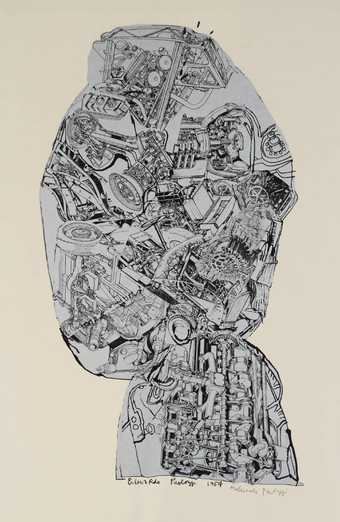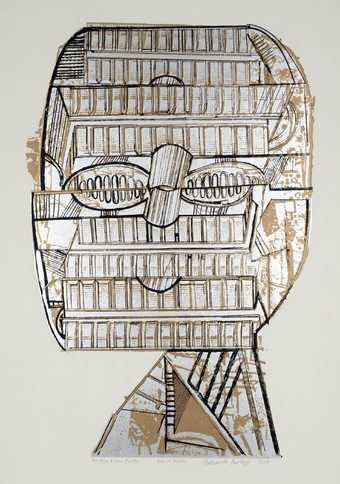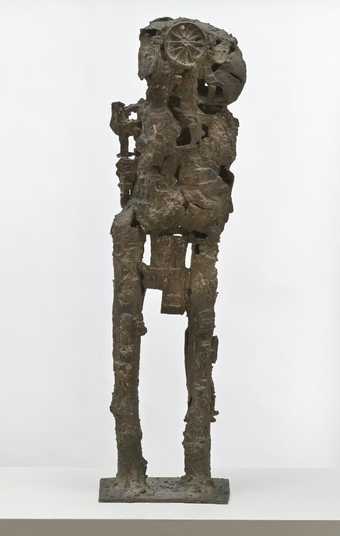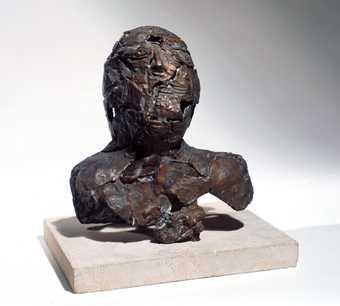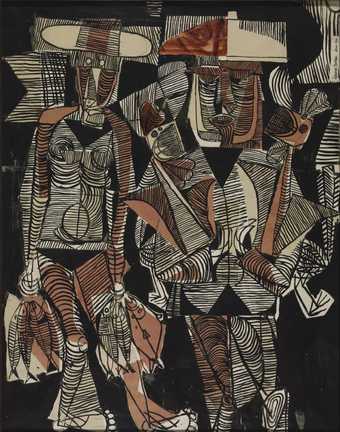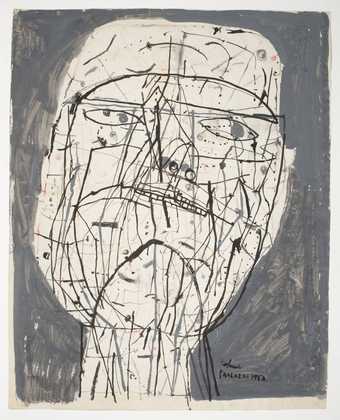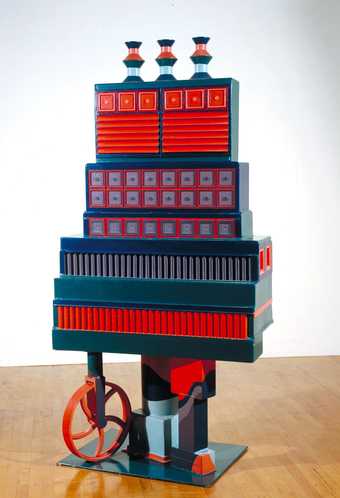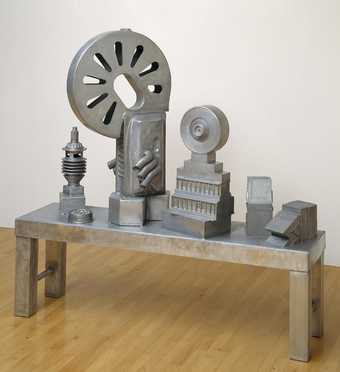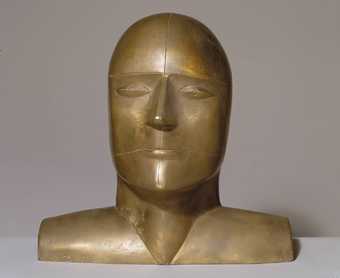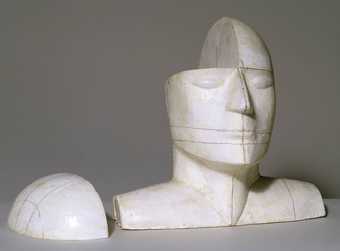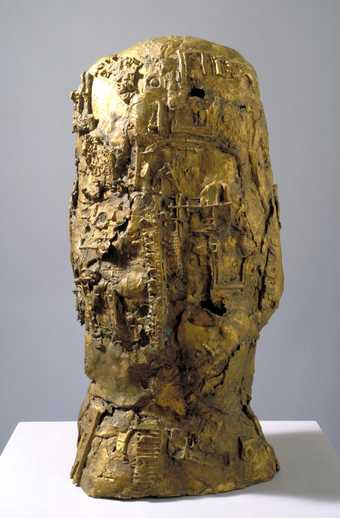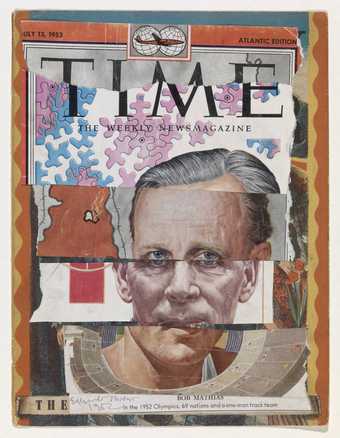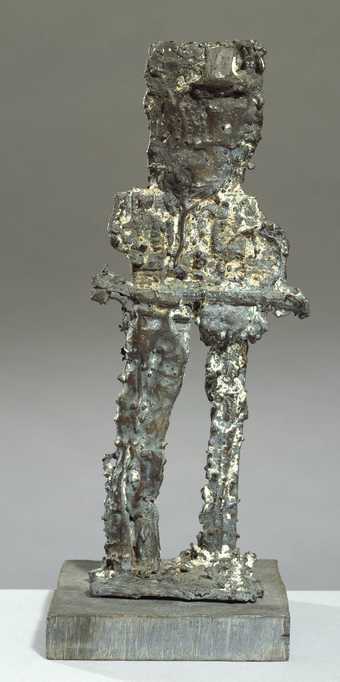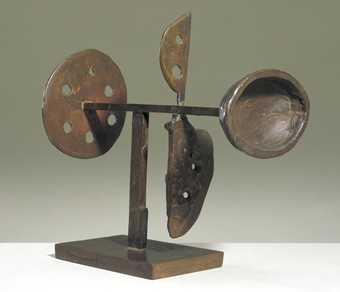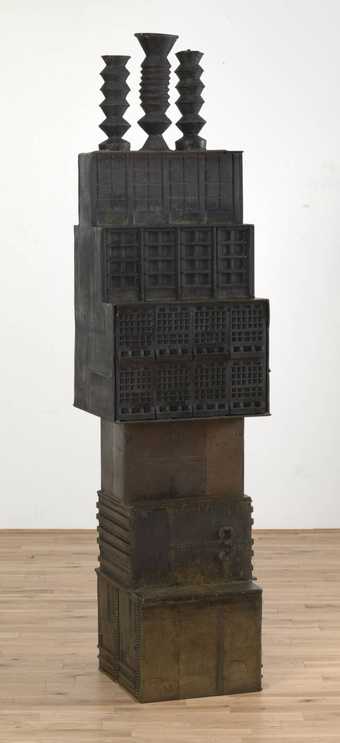
Not on display
- Artist
- Sir Eduardo Paolozzi 1924–2005
- Medium
- Tin
- Dimensions
- Object: 280 × 240 × 280 mm, 0.5 kg
- Collection
- Tate
- Acquisition
- Presented by the artist 1995
- Reference
- T06931
Summary
Eduardo Paolozzi started collecting images from popular American publications and pasting them into scrapbooks when he was a child and continued to do so as an adult. Collectively these scrapbooks form an archive of mass media imagery ranging from cartoons and B-movies to advertisements and popular science. Among the many cuttings in the Crane and Hoist Engineering scrapbook (The National Art Library Archive) there are two, one from the National Geographical Magazine and the other from Time Magazine, about research at the Massachusettes Institution of Technology into the treatment of deep brain tumours using super-voltage X-rays. Both include photographs of a wooden head called Mr Cruikshank, and carry respectively the captions '"Mr Cruikshank" Plays a Brainy Role in Cranial X-rays' and 'Wooden Head is Target for X-Ray Research'. The head, made from layers of wood and other materials to simulate the densities of human bone and tissue, was used to measure the penetration of X-rays into a human skull. According to the cuttings, the scientists had chosen the name Mr Cruikshank randomly. Included in the same scrapbook are several images of figures transformed by technological apparatus into futuristic looking beings. The imagery of man in a technological age was a major theme in Paolozzi's work during the 1950s.
Working from the magazine photographs, Paolozzi made a clay copy of the wooden head and retained all the lines of division visible in the dummy. The clay head was first cast in plaster, and then in bronze. Titled Mr Cruikshank (Tate T03764), it was cast in an edition of nine in 1950. Later that year Paolozzi decided to use the plaster original (Tate T03765) as the basis for Tin Head - Mr Cruikshank. This sculpture, which is made from the tin cans salvaged from restaurants, is unique. Using a process similar to collage, Paolozzi hammered the tin over the plaster head and then soldered the small strips of metal together. The rough surface is in marked contrast to the highly finished aesthetic of Henry Moore and Barbara Hepworth, the most well-known practitioners of avant-garde sculpture in Britain at the time. Conceptually too Tin Head - Mr Cruikshank is at odds with the romantic universalism associated with Moore and Hepworth. Quite apart from the cultural specificity of Paolozzi's reference to American magazines for images, his choice of scientific equipment as subject matter is provocatively materialistic, given that such equipment serves an empirical investigation into material reality.
Tin Head - Mr Cruikshank was made in London, possibly at the Central School of Art where Paolozzi was teaching textile design, or at his studio in Radnor Walk, Chelsea. It was first exhibited at the Hanover Gallery, London, in 1950 in a group show with Kenneth King and William Turnbull.
Further reading:
Diane Kirkpatrick, Eduardo Paolozzi, London 1970
Eduardo Paolozzi: Sculpture, Drawings, Collages and Graphics, exhibition catalogue, Arts Council of Great Britain, London 1976
Fiona Pearson, Eduardo Paolozzi, exhibition catalogue, National Galleries of Scotland, Edinburgh 1999
Toby Treves
October 2000
Does this text contain inaccurate information or language that you feel we should improve or change? We would like to hear from you.
Display caption
Historically portrait busts have celebrated an individual, but this sculpture commemorates a scientific device. It is based on the model of a human head developed at the Massachusetts Institute of Technology. For this work Paolozzi cut up tin cans into thin strips and soldered the metal together to make the bust. The subject, material and technique are all manifestations of the burgeoning technological age of the 1950s.
Eduardo Paolozzi was born at Leith, near Edinburgh in 1924. He lives and works in London.
Gallery label, August 2004
Does this text contain inaccurate information or language that you feel we should improve or change? We would like to hear from you.
Explore
- abstraction(8,615)
-
- from recognisable sources(3,634)
-
- figure(2,270)
- scientific and measuring(791)
-
- scientific model(13)
- body(4,878)
-
- head / face(2,497)
- social comment(6,584)
-
- machine age(49)
You might like
-
Sir Eduardo Paolozzi Automobile Head
1954–62 -
Sir Eduardo Paolozzi Hero as Riddle
1963 -
Sir Eduardo Paolozzi Cyclops
1957 -
Sir Eduardo Paolozzi Shattered Head
1956 -
Sir Eduardo Paolozzi Fisherman and Wife
1946 -
Sir Eduardo Paolozzi Man’s Head
1952–3 -
Sir Eduardo Paolozzi The City of the Circle and the Square
1963 and 1966 -
Sir Eduardo Paolozzi Mechaniks Bench
1963 -
Sir Eduardo Paolozzi Mr Cruikshank
1950 -
Sir Eduardo Paolozzi Plaster for ‘Mr Cruikshank’
1950 -
Sir Eduardo Paolozzi Cyclops
1957 -
Sir Eduardo Paolozzi One Man Track Team
1953 -
Sir Eduardo Paolozzi Standing Figure
1958 -
Sir Eduardo Paolozzi Paris Bird
1948–9 -
Sir Eduardo Paolozzi Konsul
1962

